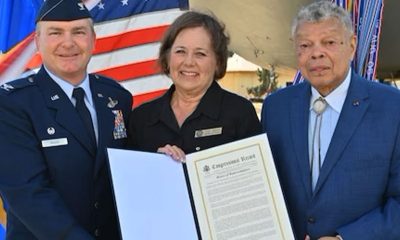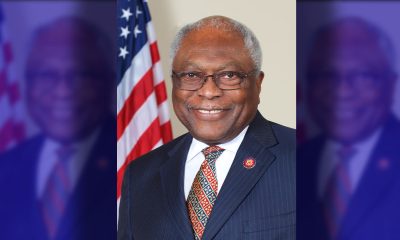Community
Khe Sanh, Part Two
To avoid an international incident, my driver and guide finished their lunch and we resumed our trip. Up to that point, no one had ever said anything negative to me about the American War—the Vietnamese name for the Vietnam War. Ironically, Most want to move on and prosper economically with the aid of the American economy. In fact, one is hard-pressed to find anyone of the war generation willing to discuss the conflict openly without government approval, and those who do request that I not mention their name or reproduce their likeness in print or video. This inebriated individual appeared to be too young to remember anything about the war other than what he gleaned from history books; so, his reaction to my presence was a bit puzzling. I must have had “I’m an American war veteran” stenciled on my forehead.
The fog and mist began settling on the tarmac as we continued to drive obscuring our vision of the school children, some walking, some riding bicycles, all wearing matching uniforms climbing the elevated slope of the mountain. Such a trek to get an education speaks reverently about the precepts found in the Analects of Confucianism which explains the Asian culture’s propensity for higher education. Stunning hues of green, shades of dark, shades of light–everywhere! Beauty that belies centuries of violent invasions from the Chinese, the French, and the Americans.
Khe Sanh! We have arrived at the town monument commemorating the battle by the same name etched in NVA filigree. These hieroglyphic pictograms tell the stories of victorious battles against the Americans. Captured American soldiers with raised hands being marched away at gunpoint is one such illustration adorning the monument. To the victor goes the history and the Vietnamese monuments and museums all tell a story of Victory against the “Imperialist Bourgeoisie.”
We first drive ten to fifteen miles in the opposite direction from the Khe Sanh Firebase over to the Lang Vei Special Forces Camp which was a forward observation post in 1968 that was overrun in the February attacks. This attack facilitated the siege of Khe Sanh eliminating a troublesome obstacle for the NVA. We’re here! We’re here? We’ve passed it? What? Lang Vei Camp has completely vanished after some 45 years. All that’s left is one road with high vegetation on either side and a tank or personnel carrier atop a hill near the entrance. Nothing to see here, so we head back to the war monument and turn left up a foggy road toward Khe Sanh Museum.
After some early missteps and lost revenue, the Vietnamese government has learned to capitalize on American war nostalgia. So, in its best capitalistic practice there is a negligible cover and bathroom charge to enter the grounds and the museum. What one will find in many Vietnam war museums, indoors or outdoors, is a liberal stash of American hardware on display. War equipment from airplanes to helicopters to tanks to munitions that were abandoned, dropped, or captured.
Due to the dearth of people today, and a cool mist coupled with light falling rain, and a vast mountainous terrain, it all offers up an eerie quiet with the exception of a distant echo. Sound carries far here, even a whisper. Alas, interrupting this reflective moment is a lone peddler hobbled with a leg injury carrying a tray of American war artifacts–bullets, dog tags, and medals which he insists I buy. No amount of “No Thank you” can deter his singular purpose. As for my guide and driver, after a few photos, they appear to have abandoned me to my own devices venturing into the museum and then into the taxi, all in an attempt to avoid the elements.
The siege of Khe Sanh is so well documented that I stutter to add anything new. All I can do is walk the area and envisage the scene of exploding ammo dumps, raining (perimeter) B 52 bombs, rockets, mortar fire, and hunkered down Marines. The siege lasted approximately three months and ended in a whimper without the long anticipated NVA ground assault. Historians have concluded the entire siege was a diversionary tactic in order to conceal the North Vietnamese government’s real intention—Tet. The importance of Khe Sanh deals more with President Johnson’s fear of another Dien Bien Phu disaster and his preoccupation, even to the extent of maintaining a mockup model in the White House, with defending it at all costs. This was going to be a last stand battle that America was not going to lose.
After leaving Khe Sanh, I concluded that it was not feasible to head over to Hamburger Hill with the time I had left. I would have to stop in Aluoi and get a special permit and guide from town officials. I suspect the reason for this precaution is the continued danger presented by unexploded ordinance as a result of this tumultuous battle. One would be foolhardy to try and go there alone.
NVA = North Vietnamese Regular Army
For more information visit:
Alameda County
DA Pamela Price Stands by Mom Who Lost Son to Gun Violence in Oakland
Last week, The Post published a photo showing Alameda County District Attorney Pamela Price with Carol Jones, whose son, Patrick DeMarco Scott, was gunned down by an unknown assailant in 2018.

Publisher’s note: Last week, The Post published a photo showing Alameda County District Attorney Pamela Price with Carol Jones, whose son, Patrick DeMarco Scott, was gunned down by an unknown assailant in 2018. The photo was too small for readers to see where the women were and what they were doing. Here we show Price and Jones as they complete a walk in memory of Scott. For more information and to contribute, please contact Carol Jones at 510-978-5517 at morefoundation.help@gmail.com. Courtesy photo.
City Government
Vallejo Welcomes Interim City Manager Beverli Marshall
At Tuesday night’s Council meeting, the Vallejo City Council appointed Beverli Marshall as the interim city manager. Her tenure in the City Manager’s Office began today, Wednesday, April 10. Mayor Robert McConnell praised Marshall’s extensive background, noting her “wide breadth of experience in many areas that will assist the City and its citizens in understanding the complexity of the many issues that must be solved” in Vallejo.

Special to The Post
At Tuesday night’s Council meeting, the Vallejo City Council appointed Beverli Marshall as the interim city manager. Her tenure in the City Manager’s Office began today, Wednesday, April 10.
Mayor Robert McConnell praised Marshall’s extensive background, noting her “wide breadth of experience in many areas that will assist the City and its citizens in understanding the complexity of the many issues that must be solved” in Vallejo.
Current City Manager Michael Malone, whose official departure is slated for April 18, expressed his well wishes. “I wish the City of Vallejo and Interim City Manager Marshall all the best in moving forward on the progress we’ve made to improve service to residents.” Malone expressed his hope that the staff and Council will work closely with ICM Marshall to “ensure success and prosperity for the City.”
According to the Vallejo Sun, Malone stepped into the role of interim city manager in 2021 and became permanent in 2022. Previously, Malone served as the city’s water director and decided to retire from city service e at the end of his contract which is April 18.
“I hope the excellent work of City staff will continue for years to come in Vallejo,” he said. “However, recent developments have led me to this decision to announce my retirement.”
When Malone was appointed, Vallejo was awash in scandals involving the housing division and the police department. A third of the city’s jobs went unfilled during most of his tenure, making for a rocky road for getting things done, the Vallejo Sun reported.
At last night’s council meeting, McConnell explained the selection process, highlighting the council’s confidence in achieving positive outcomes through a collaborative effort, and said this afternoon, “The Council is confident that by working closely together, positive results will be obtained.”
While the search for a permanent city manager is ongoing, an announcement is expected in the coming months.
On behalf of the City Council, Mayor McConnell extended gratitude to the staff, citizen groups, and recruitment firm.
“The Council wishes to thank the staff, the citizens’ group, and the recruitment firm for their diligent work and careful consideration for the selection of what is possibly the most important decision a Council can make on behalf of the betterment of our City,” McConnell said.
The Vallejo Sun contributed to this report.
City Government
Vallejo Community Members Appeal Major Use Permit for ELITE Charter School Expansion
Vallejo community members, former Solano County judge Paul Beeman and his wife Donna Beeman, filed an appeal against the approval of the Major Use Permit for the expansion of ELITE Public Schools into downtown less than two weeks after the Planning Commission approved the permit with a 6-1 vote.

By Magaly Muñoz
Vallejo community members, former Solano County judge Paul Beeman and his wife Donna Beeman, filed an appeal against the approval of the Major Use Permit for the expansion of ELITE Public Schools into downtown less than two weeks after the Planning Commission approved the permit with a 6-1 vote.
ELITE Charter School has been attempting to move into the downtown Vallejo area at 241-255 Georgia Street for two years, aiming to increase its capacity for high school students. However, a small group of residents and business owners, most notably the Beeman’s, have opposed the move.
The former county judge and his wife’s appeal alleges inaccuracies in the city’s staff report and presentation, and concerns about the project’s exemption from the California Environmental Quality Act (CEQA).
The Beeman’s stress that their opposition is not based on the charter or the people associated with it but solely on land use issues and potential impact on their business, which is located directly next to the proposed school location.
The couple have been vocal in their opposition to the expansion charter school with records of this going back to spring of last year, stating that the arrival of the 400 students in downtown will create a nuisance to those in the area.
During the Planning Commission meeting, Mr. Beeman asked Commissioner Cohen-Thompson to recuse herself from voting citing a possible conflict of interest because she had voted to approve the school’s expansion as trustee of the Solano County Board of Education. However, Cohen-Thompson and City Attorney Laura Zagaroli maintained that her positions did not create a conflict.
“I feel 100% that the attorney’s opinion is wrong,” Beeman told the Post.
He believes that Cohen-Thompson has a vested interest in upholding her earlier vote as a trustee and is advocating for people to ratify her opinion.
Cohen-Thompson declined to comment on the Post’s story and Zagaroli did not respond for comment.
The Beeman’s further argue that the school’s presence in the commercial district could deter future businesses, including those who sell alcohol due to proximity to schools.
According to Alcohol Beverage Control (ABC), the department can deny any retail license located within 600 feet of a school. Only one alcohol selling business is located within that range, which is Bambino’s Italian restaurant at 300 feet from the proposed location.
The project’s proponents argue that the school would not affect current or future liquor-selling establishments as long as they follow the ABC agency’s guidelines.
The Beeman’s also referenced Vallejo’s General Plan 2040, stating that the proposed expansion does not align with the plan’s revitalization efforts or arts and entertainment use. They argue that such a development should focus on vacant and underutilized areas, in accordance with the plan.
The proposed location, 241 Georgia Street aligns with this plan and is a two minute walk from the Vallejo Transit Center.
The General Plan emphasizes activating the downtown with, “Workers, residents, and students activate the downtown area seven days a week, providing a critical mass to support a ‘cafe culture’ and technology access, sparking innovation and entrepreneurship.”
City staff recommended exempting the project from CEQA, citing negligible impacts. However, Beeman raised concerns about increased foot traffic potentially exacerbating existing issues like theft and the lack of police presence downtown. He shared that he’s had a few encounters with kids running around his office building and disturbing his work.
Tara Beasley-Stansberry, a Planning Commissioner and owner of Noonie’s Place, told the Post that the arrival of students in downtown can mean not only opportunities for surrounding businesses, but can allow for students to find their first jobs and continue to give back to the community in revitalization efforts.
Beasley-Stansberry had advocated for the students at the March Commission meeting, sharing disappointment in the way that community members spoke negatively of the teens.
“To characterize these children as criminals before they’ve even graduated from high school, that’s when I had to really take a look and I was kind of lost as to where we were as a city and as a community to where I couldn’t understand how we were viewing these children,” Beasley-Stansberry told the Post.
She added that the commissioners who voted yes on the project location have to do what is right for the community and that the city’s purpose is not all about generating businesses.
ELITE CEO Dr. Ramona Bishop, told the Post that they have worked with the city and responded to all questions and concerns from the appropriate departments. She claimed ELITE has one of the fastest growing schools in the county with mostly Vallejo residents.
“We have motivated college-bound high school students who deserve this downtown location designed just for them,” Bishop said. “We look forward to occupying our new [location] in the fall of 2024 and ask the Vallejo City Council to uphold their Planning Commission vote without delay.”
The Vallejo City Council will make the final decision about the project location and Major Use Permit on April 23.
-

 Activism4 weeks ago
Activism4 weeks agoOakland Post: Week of March 27 – April 2, 2024
-

 #NNPA BlackPress4 weeks ago
#NNPA BlackPress4 weeks agoCOMMENTARY: D.C. Crime Bill Fails to Address Root Causes of Violence and Incarceration
-

 #NNPA BlackPress4 weeks ago
#NNPA BlackPress4 weeks agoFrom Raids to Revelations: The Dark Turn in Sean ‘Diddy’ Combs’ Saga
-

 #NNPA BlackPress4 weeks ago
#NNPA BlackPress4 weeks agoCOMMENTARY: Lady Day and The Lights!
-

 #NNPA BlackPress4 weeks ago
#NNPA BlackPress4 weeks agoMayor, City Council President React to May 31 Closing of Birmingham-Southern College
-

 #NNPA BlackPress4 weeks ago
#NNPA BlackPress4 weeks agoBaltimore Key Bridge Catastrophe: A City’s Heartbreak and a Nation’s Alarm
-

 #NNPA BlackPress4 weeks ago
#NNPA BlackPress4 weeks agoBaltimore’s Key Bridge Struck by Ship, Collapses into Water
-

 #NNPA BlackPress4 weeks ago
#NNPA BlackPress4 weeks agoBeloved Actor and Activist Louis Cameron Gossett Jr. Dies at 87



















































